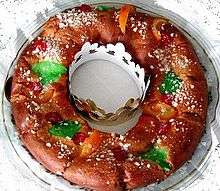Tortell
 A Tortel de Reyes This size, approx. 50 cm diameter, usually serves 8 people | |
| Alternative names | Tortell de Reis |
|---|---|
| Type | Pastry |
| Course | dessert |
| Place of origin | Spain, France |
| Region or state | Catalonia, Occitania |
| Main ingredients | Marzipan |
Tortell (Catalan pronunciation: [tuɾˈteʎ]), Tortel in Spanish or Gâteau des Rois in French (Reiaume or Corona dels Reis in Occitan) is a Catalan and Occitan pastry typically O-shaped, usually stuffed with marzipan or whipped cream, that on some special occasions is topped with glazed fruit. It is traditionally eaten on January 6 (Epiphany), at the conclusion of the Twelve Days of Christmas.[1] This is also known as the day of the Three Wise Men according to the Catholic liturgical calendar.
The tortell de Reis contains two hidden surprises: a dried field bean, and a tiny figurine of one of the three kings. The person who gets the figurine in their cut gets to wear the paper crown. The person who gets the dried fava bean in their cut has to pay for the tortell. Variants of this pastry are also popular in other places in Spain where it is known as roscón de Reyes.
In Provence, the one who gets the dried field bean gets to wear the paper crown and is the king for the day.
A similar tradition in and around New Orleans, Louisiana is the king cake while in Mexico there is a very similar dish called rosca de reyes, and in the Portuguese-speaking world the bolo rei.
References
- ↑ Mould, Michael (2011). The Routledge Dictionary of Cultural References in Modern French. Taylor & Francis. p. 17.
Bibliography
- "Christmas". Catholic Encyclopedia. Retrieved December 22, 2005. Primarily subhead Popular Merrymaking under Liturgy and Custom.
- Christmas Trivia edited by Jennie Miller Helderman, Mary Caulkins. Gramercy, 2002
- Marix-Evans, Martin. The Twelve Days of Christmas. Peter Pauper Press, 2002
- Bowler, Gerry. The World Encyclopedia of Christmas. McClelland & Stewart, 2004
- Collins, Ace. Stories Behind the Great Traditions of Christmas. Zondervan, 2003
| Wikimedia Commons has media related to Tortell de Reis. |